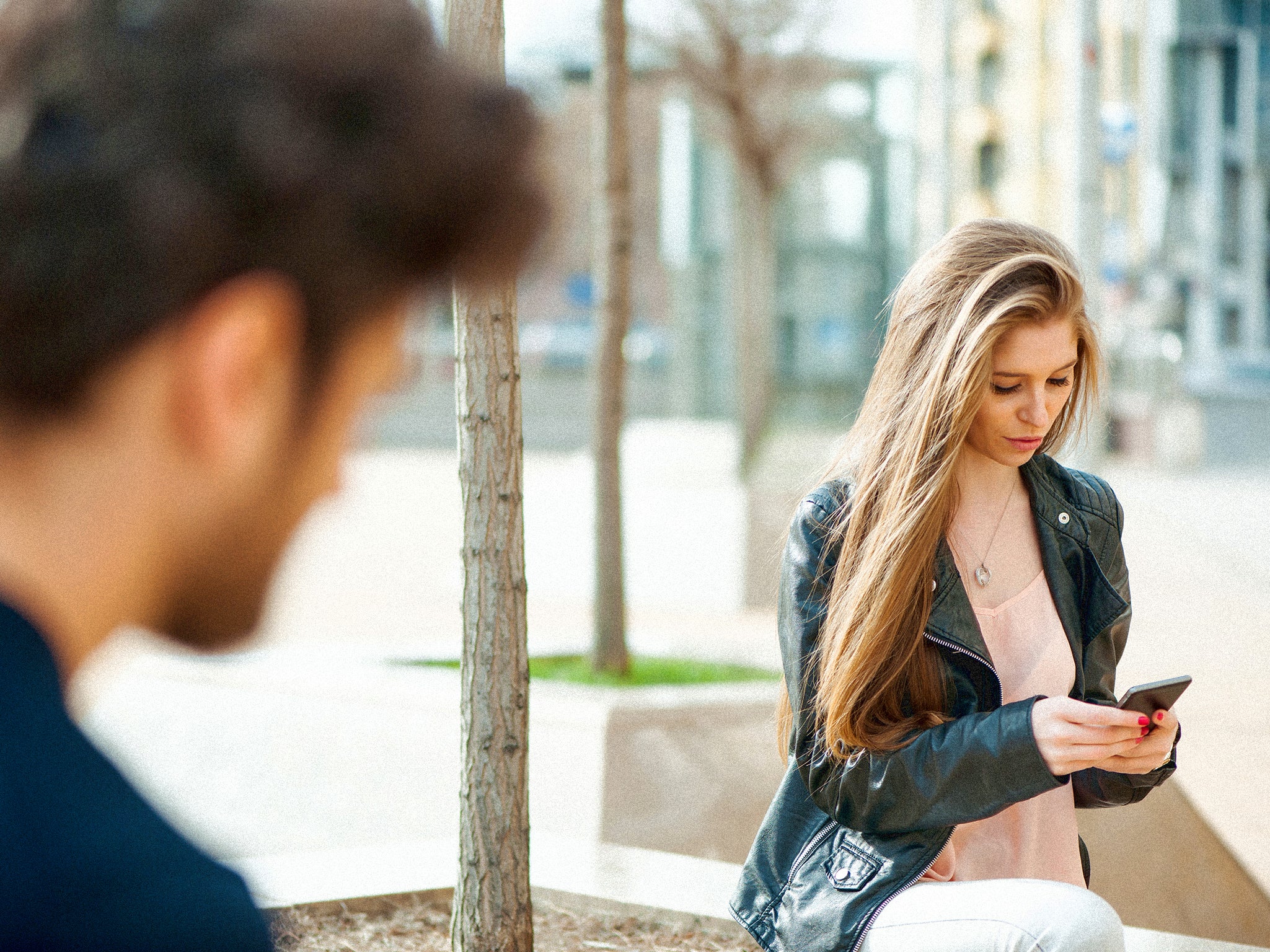Pestered, filmed and not left alone: How stranger danger went viral
As a video of a young woman crying after being touched by a TikTok dancer in public goes viral, Olivia Petter asks whether we’ve forgotten how to interact (or not interact) with total strangers


Your support helps us to tell the story
From reproductive rights to climate change to Big Tech, The Independent is on the ground when the story is developing. Whether it's investigating the financials of Elon Musk's pro-Trump PAC or producing our latest documentary, 'The A Word', which shines a light on the American women fighting for reproductive rights, we know how important it is to parse out the facts from the messaging.
At such a critical moment in US history, we need reporters on the ground. Your donation allows us to keep sending journalists to speak to both sides of the story.
The Independent is trusted by Americans across the entire political spectrum. And unlike many other quality news outlets, we choose not to lock Americans out of our reporting and analysis with paywalls. We believe quality journalism should be available to everyone, paid for by those who can afford it.
Your support makes all the difference.You’re approached by a stranger. What’s the first thing you do? Do you smile, and start talking to them about the weather? Politely turn around and walk away? Or do you recoil and start to weep? Say it’s the latter. Now imagine a video of you doing that has gone viral on social media – and millions of people are now analysing what brought you to tears, if it’s justified, and whether or not you might have autism.
This is what happened recently to a young woman who was filmed as she was approached in New York’s Times Square by 21-year-old TikTok creator and dancer, Huon Archer. In the video, which has been viewed more than 21 million times on TikTok (and 45 million on Twitter), Archer is seen dancing alongside a queue of women, tapping them on the shoulder and then holding his hand up to them for a high five. The first woman ignores him and moves away. The second appears startled and goes to her friend for support. When Archer taps the second woman’s shoulder, she obliges the high five before placing her hand on the arm of her friend, who starts to cry.
The video has prompted indignation online, with thousands of people offering their two cents. One Twitter user argued: “Super insane how someone can film you for 30 seconds and post it and end up turning you into some kind of internet figure against your will.” Another added: “The fact that he kept hovering near their group even after he saw one of the girls clearly wasn’t feeling it.” One person simply posited the idea that “we’re officially in a black mirror episode”.
Archer, meanwhile, has not publicly responded to the reaction to his video but has turned the comments off on TikTok. (The Independent has reached out to Archer for comment.) Nonetheless, it has sparked a feverish debate around social etiquette, social media and the way we interact with strangers.
“People’s brains are so broken now that they’re arguing that existing in a public place means you are implicitly agreeing to be touched and filmed by strangers and to have your emotions and reactions posted online for a million people to laugh at and psychoanalyze,” one person tweeted. “The idea that I could go out one day and have millions of people insult me online based on a 15 second clip of me that I didn’t even choose to be a part of is quickly becoming a legitimate fear,” added another.
Videos like Archer’s have become increasingly popular since the pandemic. There are now countless popular creators like him, whose content revolves around approaching strangers: the tag “approaching random people” on TikTok has more than 6.2 million views alone.
I had a guy following me for a good 15 minutes no matter how many times I told him to go away. I must have changed direction six or more times
Among them are videos of users trying to speak to people on the Tube, asking them where they’re going and who they’re with, and others simply trying to talk to people on the street. Caleb Simpson (7.1 million followers on TikTok), one of the most notorious creators of this ilk, has become famed for videos in which he asks strangers in Manhattan how much they pay for rent. There’s also Daniel MacDonald (13.9 million followers on TikTok), who asks strangers what they do for a living, and Ted Zhar (533,600 followers on TikTok). He also asks strangers (and sometimes celebrities) the same question – regular videos include “what do hot girls do for a living?”.
For some people, all this is merely innocent, insipid internet content. But as Archer’s clip shows, when you’re the stranger involved, it’s a different matter altogether. It also raises questions around what happens when this kind of behaviour is normalised on a mainstream – and offline – level.
Invading someone’s personal space in public is nothing new. And, as we know all too well, it can easily lead to more malevolent behaviour. Think back to the post-pandemic rise of discussions around public sexual harassment, which is now set to be punishable by up to two years in prison thanks to new legislation backed by the government. In December 2022, government research found that 44 per cent of people felt that public sexual harassment was happening more often in England and Wales than five years before (including 18 per cent who felt that it was happening much more often). Meanwhile, the Office for National Statistics found in May 2022 that one in two women aged between 16 and 34 years experienced one form of harassment in the previous 12 months, with 38 per cent of women aged between 16 and 34 having experienced catcalls, whistles, unwanted sexual comments or jokes, and 25 per cent having felt that they were being followed.
These incidents are as varied as they are numerous, but one thing connects them all: they all involve strangers approaching people in an unsavoury manner in public. There have been more specific conversations, too. Earlier this year, the hashtag #GymCreep went viral on TikTok as a way of women showcasing how frequently they were approached or stared at by predatory men while working out. Elsewhere, the British Transport Police has upped its safeguarding measures, with TfL launching a campaign urging bystanders to “safely intervene” if they witnessed instances of sexual harassment.
Of course, all of this has been happening for some time. But the nature of these interactions seems to have changed following the pandemic. “I think post-MeToo, I’ve experienced less of the low-level harassment like catcalling. But I’ve had more of the most insidious kind recently,” says performer George Lou Bon, 28, who runs the @itsmybody Instagram account. “Not long ago, I had a guy following me for a good 15 minutes no matter how many times I told him to go away. I must have changed direction six or more times before I decided to just stop in the middle of a junction and call someone.”

This has also been the case for Molly*, 55, who has had several severe incidents of public harassment since the pandemic, including being complimented about the shape of her body in a pair of gym leggings while walking to work. She has also been filmed by a man on the Tube without her consent. “At first, I just thought he must be watching a film, then I realised he was filming me. I ignored it until it carried on for another couple of stops. In the end, I asked him to stop filming me. He ignored me and continued, so I got off at the next stop.”
Of course, not every public interaction with a stranger is harassment. And there are some who would argue that in today’s hyper-aware society, harmless interactions can easily be misconstrued as predation, or something equally as harmful. There are also those who want to be filmed, often doing strange things in public with the intention of just that – think of the man who recently went viral with his sparky response to a TikToker on Leicester Square who asked if he’d ever start his own business (he winked at the camera).
But it’s clear to see that such interactions can and do cause discomfort, particularly as they are becoming more prolific. After all, how relevant is someone’s intention when it has the propensity to cause such a visceral reaction from the individual involved, as we saw in Archer’s video? Perhaps he was just trying to film a dance video for TikTok. But, following the woman’s tears, why post it at all? And what kind of message does that send to others with regards to what is and isn’t acceptable when it comes to how we interact with strangers?
These are questions worth considering not just as creators but as consumers, too. Ultimately, we’re the ones watching the content and breathing new life into it with every click and comment. It’s difficult to know how to deal with being approached in public. But at home, it might be smart to just close the tab.



Join our commenting forum
Join thought-provoking conversations, follow other Independent readers and see their replies
Comments